The best features of Pimcore CMS: How to use them and when
Pimcore CMS has a lot to offer, but what are its best features?
In this week’s article, we’ll talk about the best features that Pimcore CMS brings to the table.
Firstly, saying it’s a CMS may even be a wrongful statement, as it progressed far beyond the definition of a CMS. Stay with us and learn more about the best features of Pimcore CMS!
And if you’re looking for a solution partner to help you out on a project – you need to search no more! We’re a certified Pimcore Gold partner with numerous successful projects and we’d be happy to offer our services of Pimcore development!
But for now, let’s keep up with the article and find out more about Pimcore’s CMS!
The evolution from CMS to DXP
To truly appreciate the extent of the power demonstrated by Pimcore’s DXP, we’ll need to go back a few years.
In the early 2000s, the monolithic CMS was introduced. It represented a revolution in content management. It was in this period that CMS platforms such as Drupal and WordPress became popular. Back then, these platforms were capable of handling text, images, other file formats, and even downloadable content.
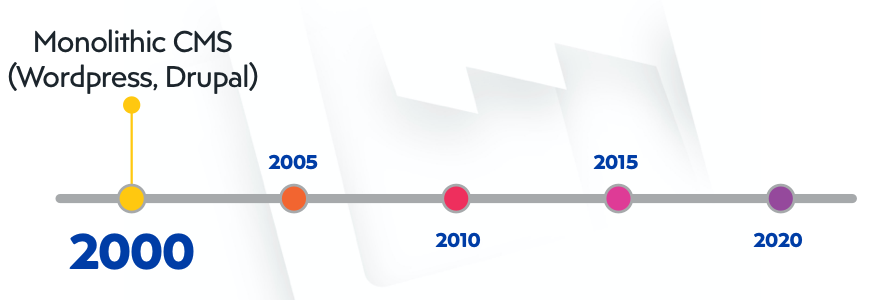
Only a few years later, around 2010, mobile devices came to the spotlight. We remember this technological boom very well, including the introduction of smart tablets, smartphones, and other smart devices. The amount of content delivered to mobile devices was at an all-time high. And just 4 years later, in 2014, mobile internet use exceeded desktop internet use in the US for the first time in history.
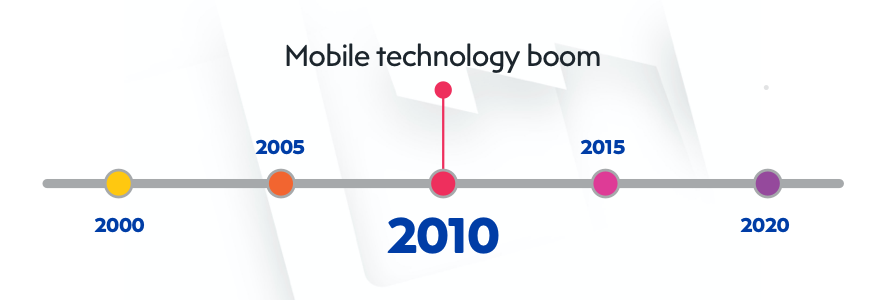
As time went by, we witnessed another technological revolution in content management – the rise of DXPs, digital experience platforms. In general, they enable building and delivering integrated and optimized experiences across all touchpoints to all audiences. The time of headless content management has begun – and Pimcore is at the forefront of this new revolution.
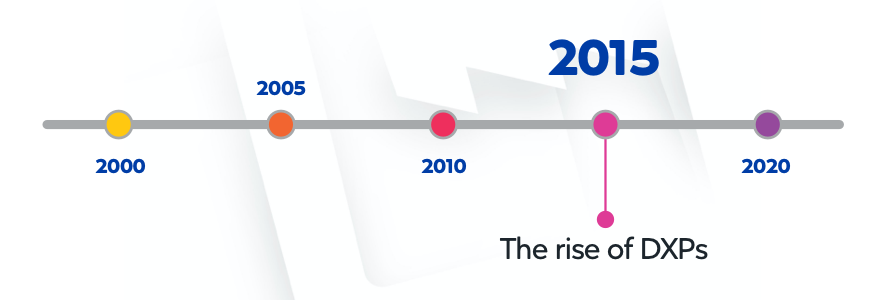
Now, how exactly does a DXP differ from CMS? In the next chapter, we’ll compare Pimcore CMS/DXP and other monolithic platforms.
The difference between Pimcore CMS/DXP and monolithic CMS
When we talk about content management systems, we tend to overuse the CMS abbreviation. Honestly speaking, CMS isn’t that relevant anymore. Today, businesses have much more complex requirements, rather than only managing content on a website. This is where monolithic CMS falls short.
Instead of simple web content management requirements, future-proof solutions such as Pimcore DXP provide businesses with an array of functionalities, such as order management, marketing campaign management, real-time analytics, and much more.
The biggest difference between a CMS and a DXP is that DXPs, such as Pimcore, always include a CMS. To be more accurate, CMS is only 1 out of 6 modules Pimcore has to offer.

A quick note here! If you’d like to learn more about different modules of Pimcore, check out our articles on digital asset management, customer data platform, product information management, and Pimcore’s eCommerce framework!
When implemented, other modules work in harmony with each other, providing businesses with real DXP benefits.
Another difference between CMS and DXP is the purpose of the system itself. For example, the purpose of a CMS, such as WordPress, is to manage content and deliver it to various output channels. On the other hand, the purpose of a DXP, such as Pimcore, is to manage the full business lifecycle, provide businesses with in-depth analytics, provide detailed reports, assist in creating marketing campaigns, organizing finances, managing customer relationships, and much more.
After reviewing all of the similarities and differences between CMS and DXP, a clear conclusion arises. DXP represents the next generation of content management. It offers much more and its purpose is more aligned with business goals and requirements than that of its predecessors.
We can even compare these two systems with standard “old school” mobile phones and today’s smartphones. Their core purpose is to enable communication between phone users, but today’s smartphones expand on that greatly. They offer incredible amounts of content in various formats and for various purposes.
Clearly, we can agree that smartphones are the next generation of mobile phones. The same happened to CMS! They got outdated.
Additionally, if you’d like to take a look at our detailed comparison of WordPress CMS alternatives, be sure to check it out and weigh in all of the factors. Also, for a more detailed comparison, check out our Pimcore vs. WordPress article to find out which CMS can suit your business the best!
Now, let’s take a look at some of the best features of Pimcore CMS/DXP and see how they fare in today’s digital world.
The best features Pimcore CMS/DXP has to offer
Before delving deeper into some of the best features of Pimcore’s CMS module, we need to first make it clear that Pimcore’s CMS functions as a headless CMS. It’s a huge plus, but, what’s a headless CMS?
So, a headless CMS is a CMS without the head (obviously), with the head representing the frontend. To make it more clear, let’s visualize it!

Here, you can see that a CMS consists of 4 crucial parts:
- Database for the content
- Admin interface that lets us edit and manage the content
- Integration of reading and writing
- The frontend that combines HTML and data from the database
If we want to convert this traditional CMS into a headless CMS, we need to remove the 4th part out of the equation. The actual website, the head of the CMS, needs to be removed. By doing that, we’ve turned this CMS into a headless one.
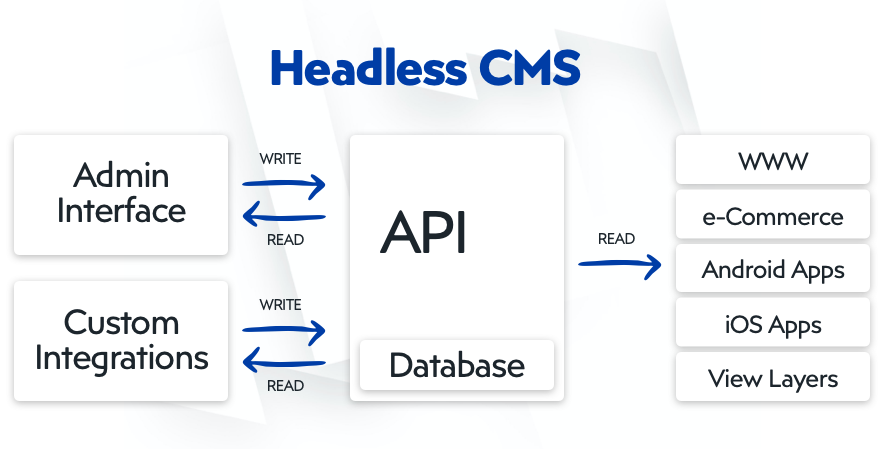
Now, a website can’t be built using only a headless CMS. As we removed the actual website from its stack, it’s required that we build a website or use content delivery API to load the content.
At first, this may seem like a step back rather than forward, but by separating the CMS from the website developers can choose any technology they’re familiar with and build the website, without learning the technology for that specific CMS. By doing this, developers won’t need to handle the bugs of an already existing technology stack, and they can more easily optimize the new website and achieve better performance and Google PageSpeed scores.
Without having a “head”, we’ve achieved a higher level of agility, and we can deliver content through APIs to any kind of output channel – kiosk, IoT devices, social platforms, online marketplaces, native apps, and so on. By removing the head, we’ve “freed up space” for CMS to connect to a higher number of output channels, all by using APIs. The whole point of removing the head from the CMS was to not limit ourselves to websites and have more freedom regarding content distribution.
Now when you have a firm understanding of a headless CMS, let’s outline some of the best features of Pimcore’s CMS/DXP and see how they fare.
WYSIWYG and high usability
In essence, Pimcore is designed to be easy to use for all technical and non-technical users. Powered by context-sensitive navigation, a variety of WYSIWYG components, and drag-and-drop functionality, it enables users to manage content in an intuitive manner.
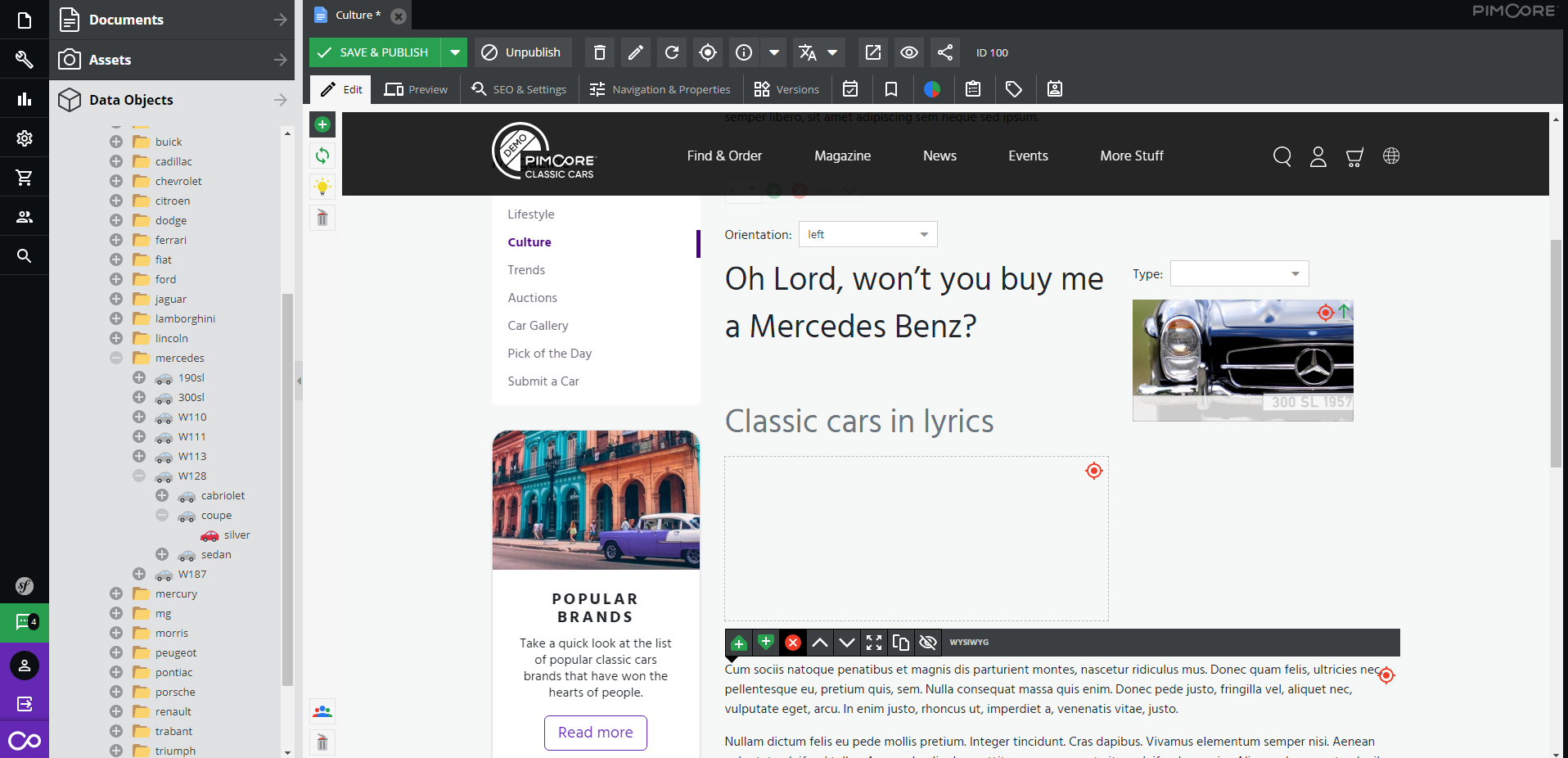
As seen in the image above, we can edit any part of the webpage by simply typing in the text, or drag-and-dropping a data object, or an asset. If we aren’t completely sure which parts we can edit without any ‘technical’ intervention, by clicking on the yellow lightbulb in the upper left corner, Pimcore will display all of the parts we can freely edit and add any type of content we want.
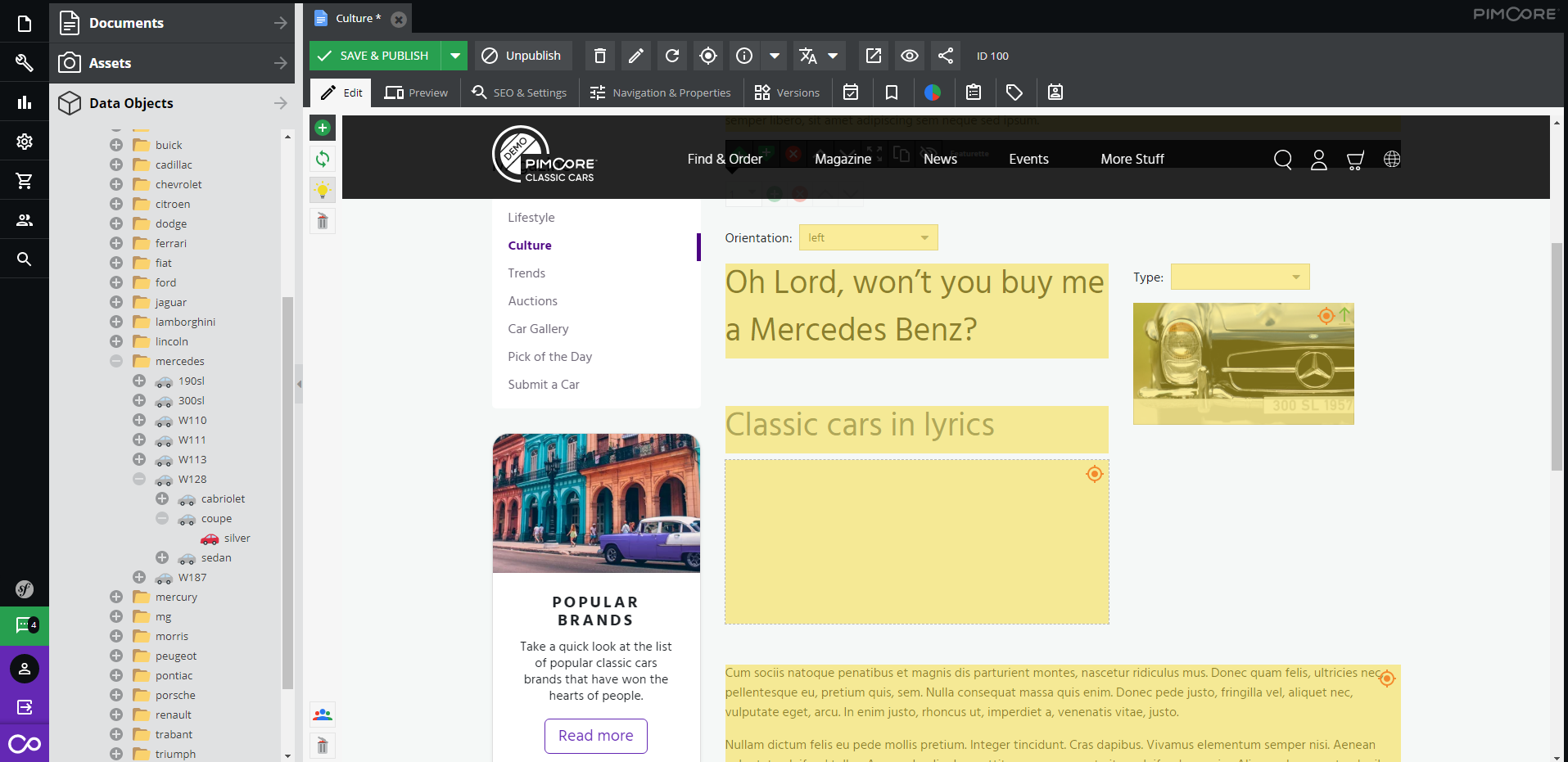
Assembling a landing page in Pimcore is easy and its WYSIWYG makes it a lot easier than it is the case with monolithic CMS.
Multi-language support
Pimcore CMS offers editors strong multi-language support, meaning that they can create new content in any supported language while working in their native language. Pimcore’s technology partners Translations.com and Across Systems extend the reach of Pimcore’s multilanguage support and enable editors to manage global enterprise content with minimal effort.

When editing a webpage, we can instantly open a translated version of the same page. The number of languages depends solely on the editor.
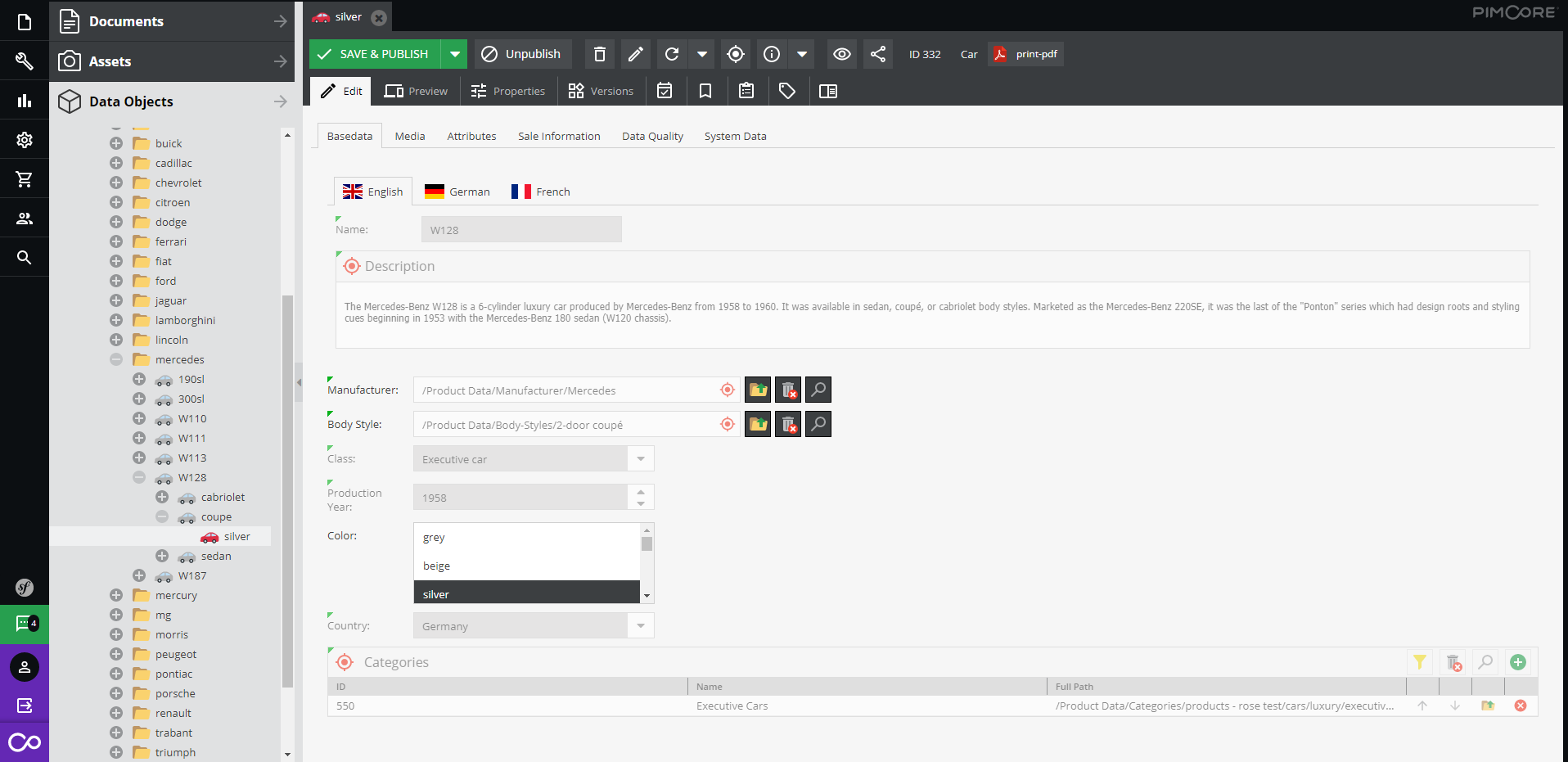
Also, when adding products, you’ll immediately see that you can add content for several languages simultaneously. You can check the completion and the quality of your input data under the “Data Quality” tab anytime. All in all, Pimcore ships with neat multilingual support that makes it easy for editors to manage content for global enterprises.
Multi-domain support
Another crucial feature Pimcore CMS has to offer is multi-domain support. As the name suggests, Pimcore enables you to manage an unlimited number of websites within a single Pimcore installation.
In short, this means that you can publish a piece of content from a central data repository across an unlimited number of websites, applications, and various devices. This is the real definition of omnipresence.
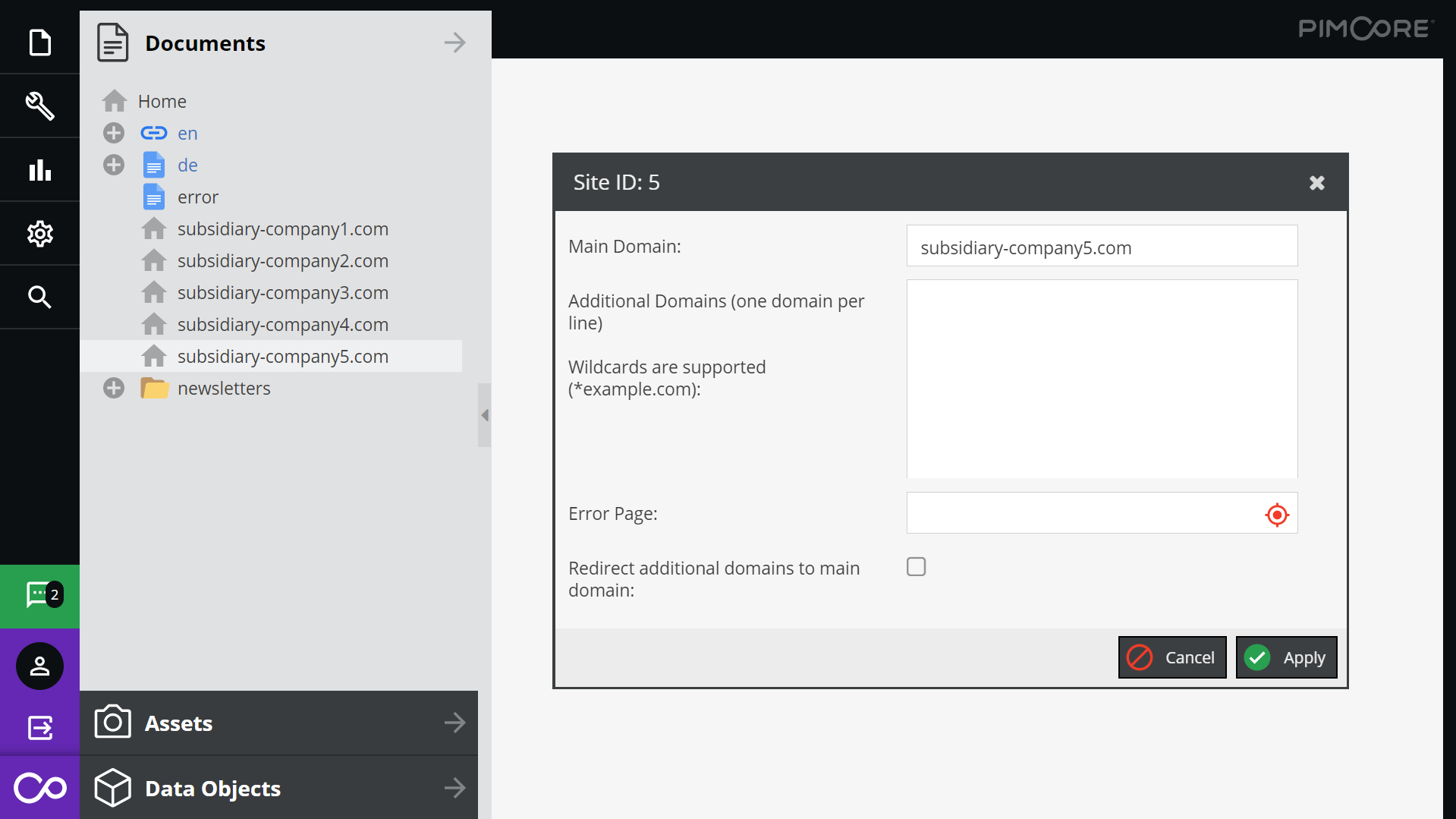
Image courtesy of Pimcore
In the image above, you can see how you can add a domain and make sure it’s under your control at any given moment.
Personalization capabilities
Pimcore CMS comes with integrated personalization functionalities. By consolidating all of the personal and behavioral data into a single data repository, Pimcore allows you to customize and personalize your customers’ experiences easily. It comes with a strong arsenal of targeting and personalization tools that use various triggers, rules, and persona profiles to make it possible for the right content to be delivered to the right customer at the right time.
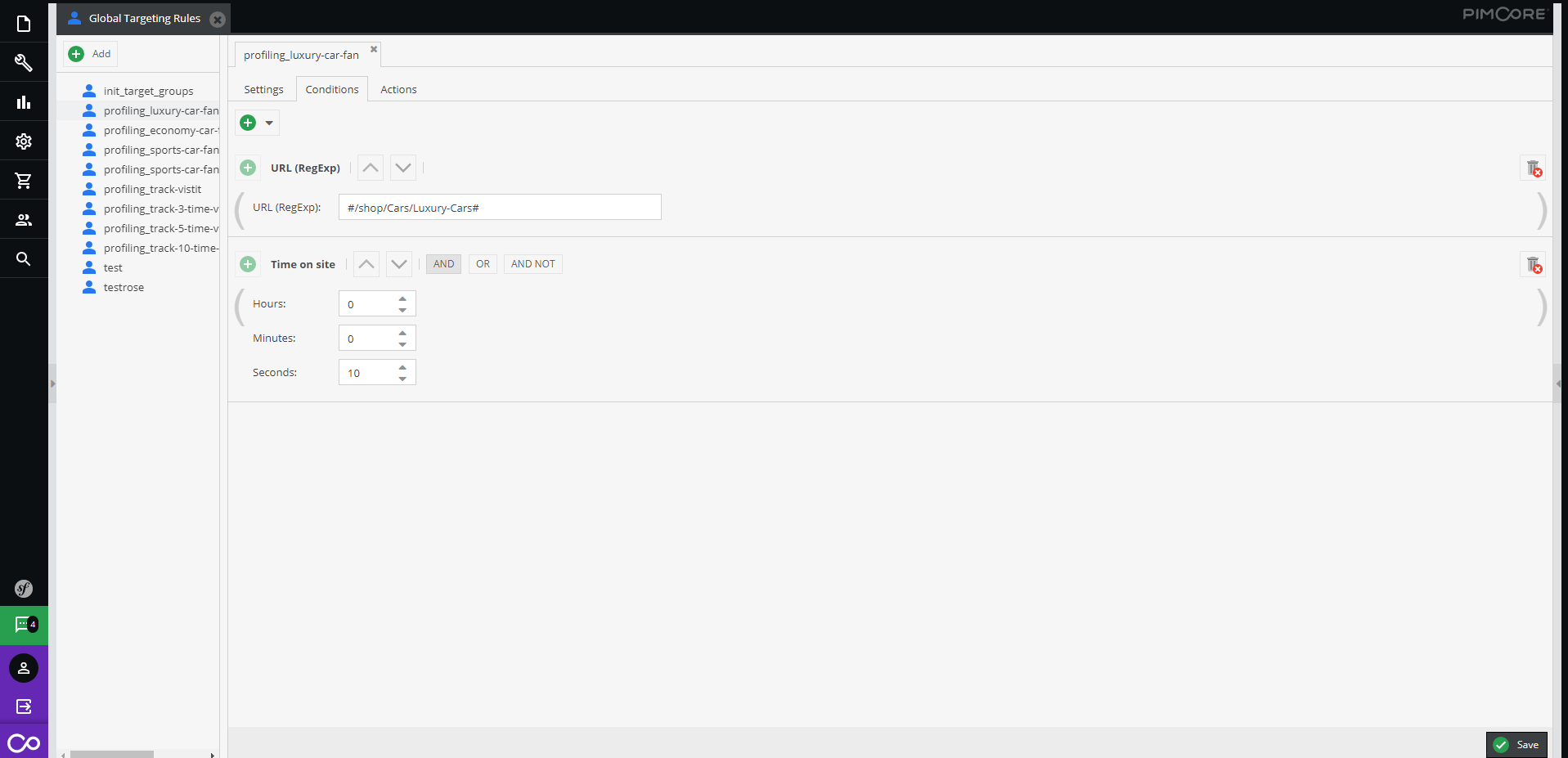
In the image above you can see a quick display of Pimcore’s global targeting rules – a huge functionality that makes delivering personalized content possible. We’ve created a guide to personalization in Pimcore, so feel free to check it out and find out how to manage and deliver personalized content to your customers!
And if you’d like to see Pimcore’s personalization engine in action – check out our step-by-step video tutorial!
Mobile-friendliness
As Pimcore functions as a headless CMS, it provides businesses with an advantage when it comes to delivering content to various touchpoints. It optimizes the mobile experience throughout the whole customer journey.
Regarding managing mobile application’s content, it’s enabled to do so directly from within the platform via the content-as-a-service paradigm. And when it comes to the development and management of responsive website content for 100% suitability to your customers – it’s fully enabled.
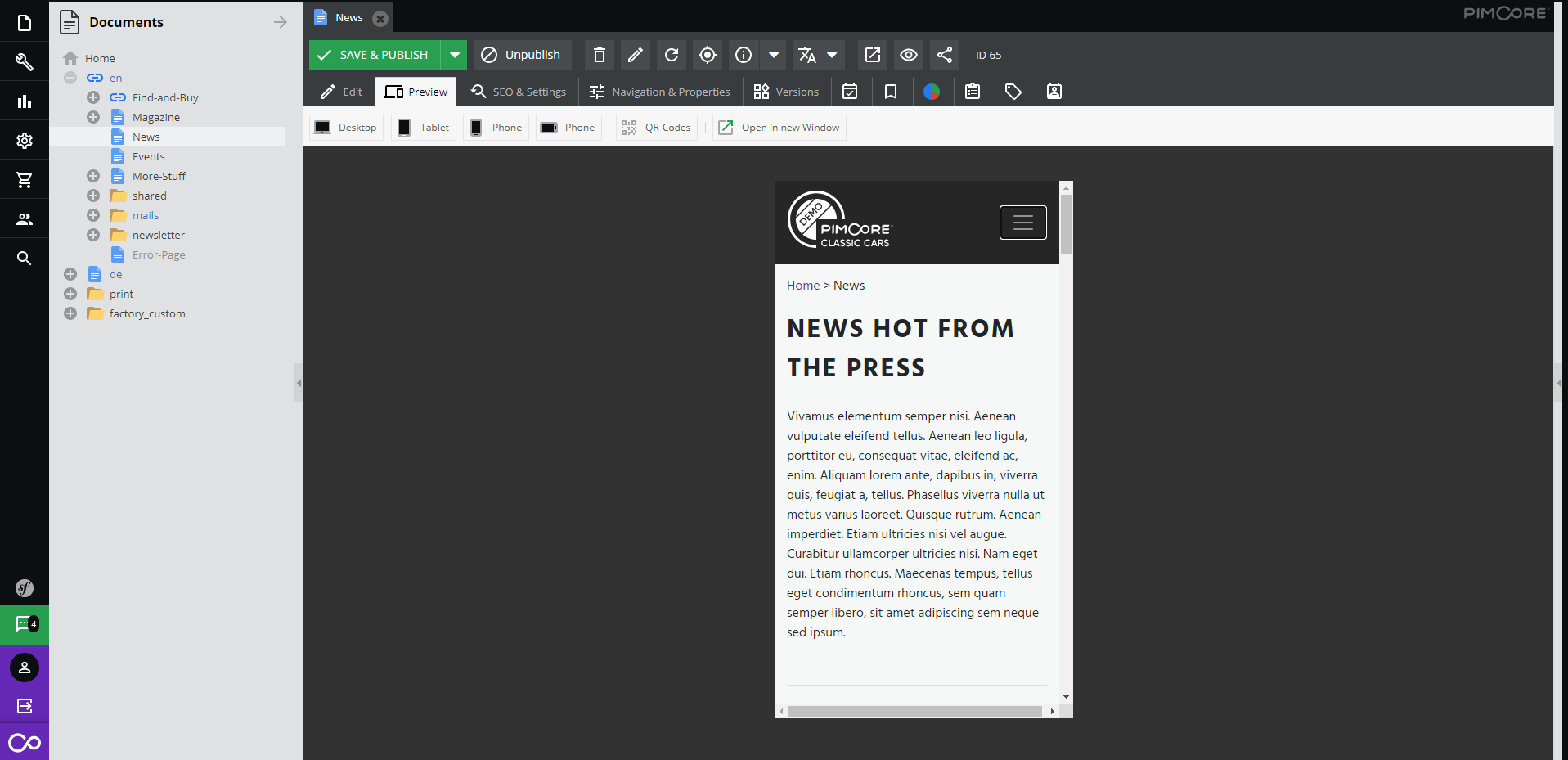
In the image above, you can see that Pimcore enables you to preview every document on any mobile device or desktop. By providing us with a real-time preview of documents, we can easily manage content and assemble documents according to the device it’s being used on.
Marketing capabilities
An array of various marketing tools comes as a core element of Pimcore CMS. Besides strong SEO tools, Pimcore includes in-depth analytics, site quality management, redirect management, and several other marketing tools as its core offering.
Taking into account the fact that digital marketing is becoming increasingly important compared to traditional marketing practices, Pimcore offers its users a complete digital marketing toolbox. Pimcore’s powerful personalization engine is only a part of Pimcore’s marketing arsenal and by incorporating all of the other mentioned marketing tools, it offers everything a digital marketer wants and needs from a CMS.
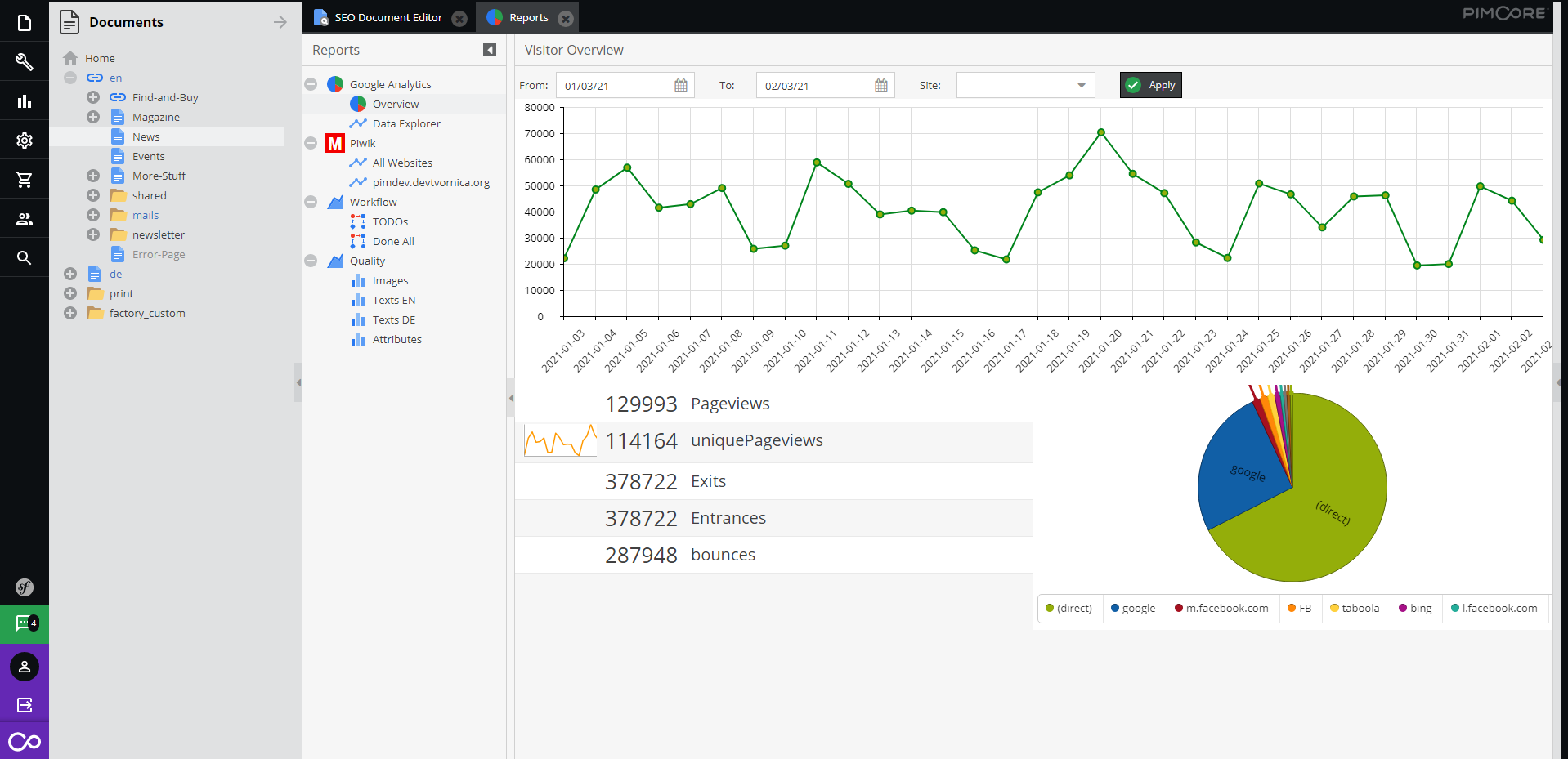
Moreover, it allows for seamless integration of Google’s essential marketing tools such as Google Analytics, Google Search Console, and Google Tag Manager. In the image above, you can see how a report from Google Analytics looks like in Pimcore’s dashboard. In essence, it means that digital marketers can rely on Pimcore to deliver the most important information within the platform, eliminating the constant need to switch to other marketing and analytics tools.
You’re looking for a new CMS?
Throughout the article, we’ve covered the best features of Pimcore CMS. It moves away from the old paradigm of monolithic CMS such as WordPress and aims to offer its users everything they need to truly manage their customers’ experiences. We’ve been contributing to the Pimcore community for quite some time, and recently we’ve built our own Pimcore knowledge base!
Here, you’ll be able to learn about Pimcore, the best Pimcore development practices, and much more! We’d love it if you’d take some time to check it out and let us know your thoughts.
And now, to summarize today’s article, we talked about:
- How CMS evolved into DXP
- What’s the difference between Pimcore CMS and other monolithic CMS
- What’s a headless CMS and how it empowers Pimcore
- Superior content editing thanks to WYSIWYG
- How to reach global audiences with multi-language support
- Pimcore’s multi-domain support
- Unparalleled personalization capabilities
- Mobile-friendliness thanks to Pimcore’s headless CMS nature
- Strong marketing tools and capabilities
All in all, Pimcore CMS proves itself to be a powerful platform for managing customer experiences throughout their whole customer journey with a number of features.
Today, when businesses are looking for ways to connect their physical presence with the digital one, having a reliable CMS is a must-have. There is a lot at stake and the whole digital presence of your business depends on how future-proof your content management strategy is.
Now, if you’re aiming to improve your digital presence and discover a whole new area of experience management, feel free to reach out to us! We want to hear your ideas and see how can we help your business with Pimcore’s CMS!
We’re a Pimcore Gold partner with a long record of successful digitalization projects and our main goal is to help you succeed.